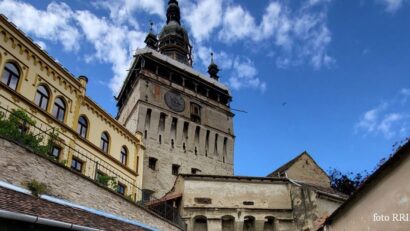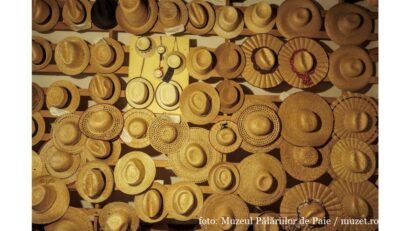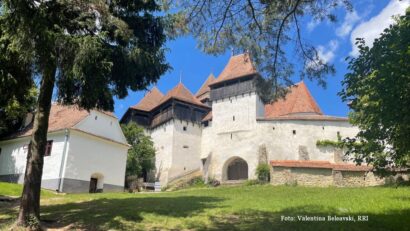Brasov
Today we'll be taking you on an imaginary journey to Brasov, in central Romania, a city renowned for its medieval architecture and the multitude of cultural events unfolding here all over the year.

Daniel Onea, 25.06.2015, 14:49
Today we’ll be taking
you on an imaginary journey to Brasov, in central Romania, a
city renowned for its medieval architecture and the multitude of cultural
events unfolding here all over the year. Spending a week in Brasov could
cater for the taste of any fastidious tourist as the region offers a lot of
opportunities to anyone interested in culture, shopping, adventure tourism or
mountain sports irrespective of the season while others can simply enjoy
outdoor activities.
Back in the medieval time,
Brasov used to be a thriving citadel, upon which it became a city that
connected the Western world with the Balkans, a major trade hub. Its historical
monuments are a delight to tourists visiting the city, standing proof of
flourishing olden times. Its surroundings are fraught with fortified churches
lying amid quiet secluded villages. In the following minutes Cristian
Macedonschi, a representative of Brasov city hall, will be introducing some of
the most important tourist attractions in the area.
Cristian Macedonschi: The Teutonic citadel of Marienburg or Feldioara is worth
visiting as there we also have the Michael Weiss monument of fallen soldiers.
We have fortified cities, UNESCO monuments, such as that in Prejmer or Viscri.
Viscri, for instance, has achieved world acclaim after the visits paid here by
Prince Charles. Then there is the Black Church, which is the Romanian monument
with the largest number of photos taken. The Bran castle lying in the region
boasts the largest number of visitors in Romania, over 550 thousand. Then there
is the fortified city of Rasnov and Brasov’s historic center flanked by the
White and Black Towers, the Weavers Bastion, The Museum of Urban Civilization.
The Museum of urban
civilization is located on the premises of the old city of Brasov housed by a
building dating back to 13th and 14th centuries. The
museum has three floors, where visitors can admire restored photo studios,
fashion design salons as well as rooms that are representatives for the life of
the bourgeoisie in mid-19th century. However, the most
representative lay monument in Brasov is the Town Hall called Casa Sfatului,
which dates back to 1420. Around this you’ll be seeing many other
representative buildings. Here is now Stelian Cosulet telling us more about the
County History Museum in Brasov.
Bogdan Cosulet: Not far from the Casa Sfatului, there is the largest building of
Brasov, St. Bartholomew’s Church dating back 1160. Historians are still takings
sides about the time the church was built. Close to it there lies the famous
Black Church, a gothic cathedral representative for the architecture in
South-Eastern Transylvania. This remains the biggest religious monument in
Romania measuring 92 meters in length. The initial project included two towers
but out of economic reasons only one tower was built. The Black Church is
presently housing major art collections that date back before Luther’s Reform,
such as a portrait of the Madonna, from the time of Matei Corvin, around
1480-1490.
Stephan
Markus Schlandt is a pipe organist at the Black Church in Brasov, where he
gives concerts on a Buchholtz mechanical pipe organ, the largest in Romania
with 3993 pipes.
Bogdan Cosulet: The Black Church was initially called St. Mary and was a Catholic
church. But Iohannes Honterus, a humanist from Transylvania of Saxon origin
changed the religious faith of the Saxons, at the same time changing the
education system; he drew a map of Transylvania, brought a printing press to
Brasov and started printing religious books in Romanian, German and Latin. The
region knew its first flourishing period around the 16th century,
through the crafts that developed here, a fact that boosted its relations with
the Ottoman Empire. For this reason we are proud to have the largest collection
of Turkish carpets outside Turkey. The city was burnt to the ground by a
powerful blaze in 1689. The buildings we see now were built after that blaze,
which affected also the Black Church, that’s why we call it black. There followed
one century of restoration. The first to be restored was the dome then the pews
and the interior decoration as well as the pipe organ.
Here is priest
Vasile Oltean with the Muzeum ‘First Romanian School’ in the oldest Brasov
district called the Schei talking about one of the oldest traditions in
the region called the Junii Festival.
Vasile Oltean: Junii of Brasov were a group of people who used to come in
their traditional folk costumes carrying battle flags and brandishing maces.
They preserved many traditions some of them dating back to the ancient kingdom
of Dacia. According to historical documents, the church in the region was built
along the years by no less than 32 rulers and boyars from Wallachia and
Moldavia and because of that, we know a fact that was also confirmed by 80
princely documents that a genuine Romanian cultural centre had emerged to have
later materialized in the first Romanian school. The first legitimate question
anyone may ask is, when did Romanians have their first school? History told us
their first school was founded in the 16th century but the church’s
chronicles read clearly, ‘the holy church was built around 1495 along with the
school’.
Brasov remains a destination for sports and
adventure lovers too. One of the most important and renowned ski resorts nearby
is Poiana Brasov, where one can find the best ski schools in winter, while in
summer one make take delight in some of the most beautiful trekking routes
where you’ll enjoy the flora and fauna of the Carpathians. Package trips to the
region can be purchased from various travel operators based in Brasov or on
line.






























